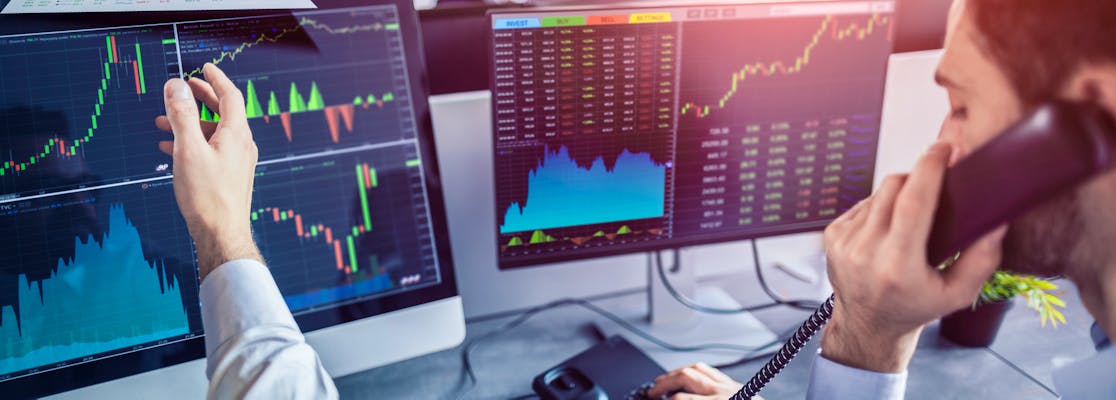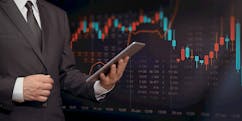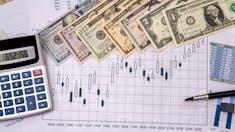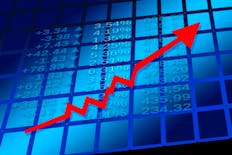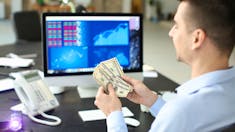What Are Forex Trading Robots & Do They Actually Work?
All products and services featured are independently selected by WikiJob. When you register or purchase through links on this page, we may earn a commission.
- A list of the Top Forex Trading Brokers for January 2025:
- Description of the Best Forex Trading Brokers for January 2025
- Our Favorite Forex Robot
empty
- What Is an Automated Trading Strategy?
- What Types of Automation Are Available?
empty
empty
- Advantages of Using Forex Robots
empty
empty
empty
empty
empty
empty
- Disadvantages of Using Forex Robots
empty
empty
empty
empty
empty
empty
empty
- Are Forex Robots Legal?
- How to Tell If a Forex Robot Isn’t Legit
- Do Forex Robots Actually Work?
- How to Use Forex Robots Successfully
- Things to Consider When Trading With a Forex Robot
- How to Pick a Legitimate Forex Robot Seller in 2025
- How to Design an Automated Trading Strategy
empty
empty
empty
empty
empty
empty
empty
- Frequently Asked Questions
- Final Thoughts
Forex trading robots are designed to help traders who want to use automated trading methods to assist with the technical analysis and repetitive elements of forex trading.
A forex robot or automated trading system is a method of trading forex using a computer program. It might also be known as an algorithmic trading system or EA (expert adviser).
Forex robots can automatically trade 24 hours per day and are simple enough to buy over the internet. But do they really work? Can they actually help traders to maximise profits?
This article is designed to give you the lowdown on what a forex robot is and provide guidance on how forex robots can be used effectively. Read on to find out more.
A list of the Top Forex Trading Brokers for January 2025:
Description of the Best Forex Trading Brokers for January 2025
1. Pepperstone
Pepperstone is a well-regarded online broker known for its competitive trading conditions, fast execution speeds, and robust platform offerings.
These features make it an excellent choice for traders using forex trading robots, also known as Expert Advisors (EAs).
Forex trading robots automate trading decisions and execute trades based on predefined algorithms, operating around the clock without human intervention.
One of the key advantages of using Pepperstone for forex trading robots is its support for popular trading platforms like MetaTrader 4 (MT4) and MetaTrader 5 (MT5).
These platforms are widely used for developing, testing, and deploying EAs. Pepperstone’s low latency and fast trade execution are crucial for the performance of forex robots, as they ensure that trades are executed swiftly and accurately, which is essential for high-frequency trading strategies.
Additionally, Pepperstone offers Virtual Private Server (VPS) hosting services, which are vital for running forex robots effectively.
A VPS ensures that the trading robots operate continuously without interruptions, maintaining connectivity and performance even when your personal device is offline.
This combination of competitive trading conditions, advanced platform support, and dedicated VPS services makes Pepperstone a preferred broker for traders looking to optimize their forex trading with automated systems.
2. IG
IG is a great share trading platform for beginners thanks to its user-friendly interface and extensive educational resources.
Pros of IG include a wide range of trading instruments and markets, as well as the ability to access multiple account types and trading platforms. The platform also offers a demo account for beginners to practise trading strategies before investing real money.
However, IG isn’t the cheapest share trading platform, with relatively high trading fees and a minimum deposit requirement of £250 when paying by credit/debit card or PayPal.
In terms of additional fees, IG charges a commission fee for share trading, starting from £8 per trade. There’s also a custody fee of 0.25% per year for holdings of £250 or more.
Overall, IG is a solid choice for beginners looking for a user-friendly platform with extensive educational resources, but investors should be aware of its fees and minimum deposit requirements.
Our Favorite Forex Robot
ForexVPS
ForexVPS is a company that provides servers specifically for trading. A Virtual Private Server (VPS) is on all the time, with no downtime – making it ideal for those who are running Expert Advisors on platforms like MT4 or 5.
To work correctly, an EA needs to be on all the time, so there are any problems with the internet connection or the terminal goes offline, you could lose opportunities and money.
Offering ultra-low latency, as little as 1 millisecond, with no sharing of resources and a 100% uptime guarantee. There are datacentres across the world that you can access through a Remote Desktop – you just need internet connection.
There are three pricing points for this service, and the only real difference is the amount of RAM and SSD that you get for your money. Starting from just £26.31 per month for 1 GB RAM, 1 CPU (Core), and 80 GB SSD, this is a service that can ensure the best performance of your robots and algorithms.
There is a way to get the mid-level package for free – through your broker. All you need to do is deposit at least the minimum and trade the monthly required volume – and there is no cost for your VPS. If you aren’t making the monthly volume, then you will only pay for the missing amount.
The ForexVPS also has a checker that you can use to test the latency of your broker.
What Is an Automated Trading Strategy?
A forex trading strategy is a set of rules a trader uses to buy and sell currency pairs. You would normally create a trading strategy and follow it manually, but many use computer programmes to implement an automated trading strategy.
Sometimes referred to as FX robots or, simply, ‘bots’, these are not physical robots – instead, they are highly specialised computer programs which have been created to carry out many different trading functions.
These range from letting traders know when to place a trade (known as ‘signals’) to automatically placing and managing trades on a trader’s behalf.
It could be an off-the-peg forex robot with its own built-in trading rules, or it could be a system the trader has designed themselves to follow their personal trading strategy.
Buying a commercial automated trading system is much easier and quicker than creating one yourself, and if you have limited experience of forex trading then you are probably better off buying one off the shelf.
There are a number of forex robots on the market. Some of them are well respected systems but others may be below par or even scams, so it is important to do your research before making a purchase and make sure you buy from a reputable source.
You should also make sure you have a full understanding of the robot you choose and are sure that it will operate in a way that aligns with your own trading goals. Things to consider include:
- Backtesting – The robot should have been backtested in different market conditions and on a range of currency pairs.
- Order size – Some robots perform best with a particular order size, so things may go wrong when the order size changes.
- Live trading results – Check that the results promised are based on trading in the live markets and not just simulations.
- Drawdown – This refers to the difference between high and low points during a specific period. Traders have their own personal preferences when it comes to drawdown, so you should choose a robot that fits your own.
- Credibility – Look for positive user reviews and testimonials.
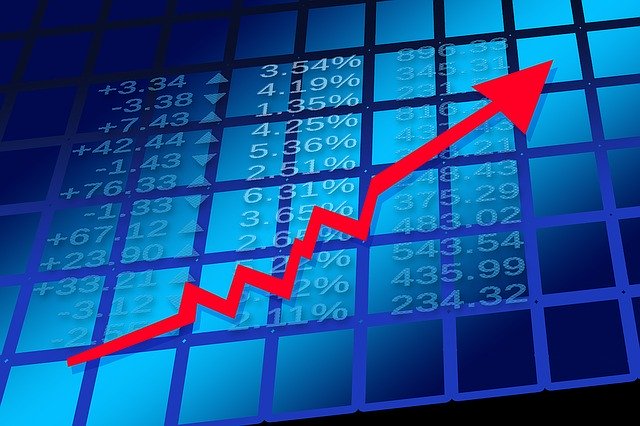
The top-rated forex robots can offer ideas on how to identify profitable trades within unpredictable markets, even when the trending direction is not obvious. These robots have the capacity to choose the most advantageous trend to increase profits and reduce the risk of loss.
For most new traders, the idea of engaging a specialised piece of computer software to carry out all of the difficult aspects of trading is likely to be very tempting.
But it’s not as simple as just going about your daily life, letting your forex robot do all of the work and watching your trading profits roll into your bank account.
Unfortunately, there are many scam robots on the market designed to make people believe that this is the case, but the best automated trading robots do require regular human input. Traders need to be able to distinguish between a scam robot and a viable robot that is worth spending money on.
What Types of Automation Are Available?
There is a broad spectrum to consider when it comes to what tasks a forex robot can actually perform. Most robots are set up to simultaneously scan and interpret millions of different forex charts in a way that a human wouldn’t ever be able to do.
Some of the simpler FX robots are programmed to simply send trading signals to traders, whilst others are able to act upon those signals; for example, by deciding when would be the best (or worst) time to trade.
There are two types of automated trading systems available:
1. Fully Automated
A fully automated trading system scans the market for trading opportunities and carries out trades electronically on behalf of its user, based on a set of predetermined rules.
It automatically generates stop-loss orders, trailing stops and profit targets as soon as a trade has been entered.
There are several benefits that you might consider when choosing to use a fully automated system. These include:
- Speed – A computer can spot and act on market opportunities much faster than a human
- Discipline – Emotions can cloud a trader's judgement; computers do not fall prey to panic or anxiety and will always stick to the plan
- Time – Using a fully automated system takes much of the work out of trading, leaving you free to do other things
If you do not have much time to devote to forex trading, or if you find it difficult to stick to a trading strategy, then a fully automated system may be a good option.
However, you should be aware that you cannot simply set it up and then sit back as the money rolls in. It will need monitoring to spot and resolve any issues.
Even the best automated systems do not offer a 100% success rate and cannot replicate many of the human qualities that make a good trader.
2. Semi-Automated
A semi-automated system uses a computer programme to analyse the forex markets and look for trading opportunities, again based on a pre-programmed trading strategy.
It then sends the user trading signals with entry prices, stop-loss orders and profit targets, and it's up to the trader to decide whether to act on these and then enter the trade manually.
As with full automation, this system frees up the trader’s time by doing much of the preliminary work for them.
It is capable of scanning and analysing the markets much quicker than a human can, and it helps to reduce emotional trading by sending alerts based only on the strategy.
This system might be better suited to a trader who has more time to spend on forex but wants to automate their activity to a certain extent.
Using a semi-automated system allows the trader to retain more control over their account and to apply their own skills, experience and knowledge before deciding whether to make a trade.
Pros
- They can trade 24/7
- They are not influenced by human emotions
- They can work faster and more effectively
- They can operate more complex and sophisticated trading strategies
- They make backtesting easier and faster
- Anyone can use them to get started with forex trading
Cons
- You need a strong and constant internet connection
- They have no capacity for human thought or imagination
- They are not good at reading and interpreting fundamental data
- They are vulnerable to non-trending markets
- Most forex robots are scalpers
- There is a risk of data-mining bias
- They may be a scam
There are several reasons why people use forex robots. However, before purchasing and running a forex robot, it is important to weigh up the advantages and disadvantages of using an automated system, and to recognise that no forex robot can offer the perfect trading solution.
Many inexperienced traders choose to use a forex robot because they are hoping to be able to easily make money from the forex market without needing to spend lots of time on trading or carry out any actions manually.
But they are not guaranteed profit-makers. Before using one, traders must first identify a good currency pair and the ideal timeframe in which to trade.
There are various pros and cons to using a forex robot, discussed in more detail below.
Advantages of Using Forex Robots
They Can Trade 24/7
Human traders are usually confined to trading within certain periods of their waking day and will usually have other commitments such as family, work and leisure pursuits. Even the most dedicated forex traders will need to take breaks to eat, drink, sleep and get away from their computer screen.
A forex robot can work continuously with no need for breaks, which means they will be watching and acting on the market at all times, so you never miss an opportunity.
They Are Not Influenced by Human Emotions
Forex robots operate on a set of pre-determined rules and they will stick to this no matter what.
When humans are trading money it can be hard for them to overcome emotions, such as fear and greed, and their own biases and assumptions. This can lead them to hesitate, prevent them from taking trades, push them into making the wrong trades or hold their position for too long.
Even when traders have a firm strategy in place it can be hard for them to think critically and objectively in the heat of the moment. An automated system removes the risk that human emotions can bring to trading.
They Can Work Faster and More Effectively
A forex robot can scan the markets, find opportunities based on pre-determined parameters and carry out trades according to its rules, all in a matter of seconds.
A human trader doing this manually is likely to take much longer and may miss opportunities, or waste time making decisions or entering an order.
They Can Operate More Complex and Sophisticated Trading Strategies
Robots are much better at multi-tasking than humans, so using an automated system allows traders to have multiple conditions for things like entries and exits, stop-loss orders and profit targets, all operating simultaneously. Forex robots can also monitor multiple currency pairs at the same time.
They Make Backtesting Easier and Faster
Backtesting is the process of testing out possible trading strategies against historical data and using this data to optimise a chosen strategy. Done manually, it is complex and time-consuming.
However, forex robots can download, store and analyse large amounts of historical data, allowing traders to measure the effectiveness of different strategies before applying them to the live market.
Anyone Can Use Them to Get Started With Forex Trading
The easy availability of forex robots means you do not have to be an expert to get one up and running on your computer and start trading forex.
However, you should always thoroughly research any automated trading system that you are considering buying and try it out on a demo account before moving onto the live market.
But using a forex robot can help you to dip your toe in the water, while freeing up your time to study forex and trading in more depth.
Disadvantages of Using Forex Robots
You Need a Strong and Constant Internet Connection
Forex robots must be run on a good computer with a reliable connection to the internet. Any delays or faults in the server could cause glitches or prompt the robot to trade incorrectly.
And like any other computer software, they could also be affected by hackers and viruses.
They Have No Capacity for Human Thought or Imagination
Successful forex traders bring a breadth of skills and knowledge to the table, applying research, analytical thinking, observation, and a certain amount of imagination and creativity to predict how markets may evolve in the near future.
Forex robots can only operate based on how they were originally programmed and their past performance, which can put them at a disadvantage to human traders.
They Are Not Good at Reading and Interpreting Fundamental Data
Forex robots are good at technical analysis, which involves reading historical market statistics and price charts to predict what might happen in the future. But they are not so helpful when it comes to fundamental analysis.
Fundamental analysis is a method of evaluating the value of an asset by looking at external circumstances and influences, such as economic or political events and industry trends.
While a human can keep abreast of what is going on in the outside world and how this might affect the markets, a quick reverse in the market caused by a sudden extreme event could severely affect a robot’s capacity to trade effectively.
They Are Vulnerable to Non-Trending Markets
Forex robots are designed to find positive trends and trading signals in the market and to act on those. This is fine if the market is trending – if the price is generally moving in one direction. But if the market becomes choppy or sideways – when the price movement is horizontal – a robot’s functionality can be affected.
Most Forex Robots Are Scalpers
Forex scalping is a trading method that involves holding currency pairs for a short period to make numerous small profits.
Generally, small price movements occur throughout the day and scalpers take advantage of this by opening and closing a large number of positions within one day. The aim is to make small gains of perhaps 5 to 20 pips per trade (a pip is the unit of change in a currency pair).
The majority of forex robots operate on a similar system, setting a target of just a few pips on every position they take.
As well as deciding if this method of trading will be profitable for you in the long term, you will also have to check your broker’s policy on scalping as not all will allow it. And you will need to confirm that your broker's spreads (the difference between the bid price and the ask price) are low enough for your chosen robot to work effectively.
There Is a Risk of Data-Mining Bias
Data-mining bias is where an analyst repeatedly searches sample data until a pattern is found, resulting in undue significance being given to a market event that was perhaps caused by chance or an unforeseen set of circumstances.
In the same way, commercial forex robots tend to pick one backtest out of hundreds and present it to the trader as the most likely outcome even though the findings may not have been tested thoroughly enough.
They May Be a Scam
It is important to be aware that forex robot scams are not uncommon, so you should be very careful about who you buy any software from. Even those that are sold in good faith may be badly designed and not live up to your expectations.
Make sure you do plenty of research before making any purchase and remember, if the promises of overnight riches sound too good to be true, they probably are.
Are Forex Robots Legal?
Forex robots are legal, but legal doesn’t necessarily mean reliable and legitimate. Certain countries do not support the use of forex robots, and there are also a handful of brokers who frown upon this method of trading.
The nervousness surrounding robots stems from the marketplace being littered with scams; it is not highly regulated. Companies can sell useless robots and traders often have no comeback where the law is concerned.
Automated robots can be bought online legally, but it is not unusual for companies to disappear as quickly as they spring up. Sellers often promote a money-back guarantee with the sale of a robot, but that guarantee vanishes with them, leaving the trader out of pocket.
Out of the many companies selling forex robots, few have legitimate software for properly assessing opportunity and risk. Many of them use tactical visual representations to trick the trader into thinking the robot on offer will generate huge profits.
Common tactics include:
-
Picking the best backtest (sometimes called data-mining bias) – Backtesting is the process through which a trader uses historical data to assess the viability of a piece of software, model or strategy. Backtesting allows the trader to simulate market conditions and watch how things would have played out. Companies looking for a quick sale of an illegitimate robot may look through hundreds of backtests and cherry-pick one, which they then present to the trader as being the likely outcome if the robot is used.
-
Curve fitting – The term ‘curve fitting’ is used in several different ways in this industry. It can refer to the adjusting of a system to, quite literally, fit in with the curve. Companies selling illegitimate forex robots may adjust parameters when backtesting, so that if, for example, a backtest shows a big loss being incurred three out of four Thursday afternoons in a month, the robot will be coded to stop trading at midday on a Thursday. Therefore, when the seller runs the code again, the data presented to the trader will look flawless.
-
Showing impressive win rates through scalping strategies – Some companies can show impressive win rates, but the likelihood is that the robot trades for small profits using a scalping (making profit from small price changes) trading style. The danger with a scalping strategy is that it only takes one large loss or a few smaller losses (due to conditions in the market changing) to wipe out all profits.
-
Using unregulated brokers – Often, robots that show very good results are also linked to brokers that are not regulated. The likelihood is that if you start trading using an illegitimate robot, your spread (the cost of a trade – a bit like a commission) will be far wider than those related to the results you were shown before purchasing, which will eat into your profits.
How to Tell If a Forex Robot Isn’t Legit
If it seems too good to be true, it probably is; effective forex robots aren’t cheap. Here are some tips on how to tell if your forex robot isn’t legal/legit:
-
It is free or cheap. If you’re surprised at how reasonably priced a forex robot is, move on. The likelihood is that it is not worthy of the money you are considering paying for it, and you won’t break even when it comes to the profit you will make off the back of it.
-
Grand claims are being made. If a company is guaranteeing big profits with minimal financial risk, promising zero spreads or making other grand statements, suspicions should be raised. There is no such thing as guaranteed profit where forex robots are concerned, and a legitimate forex robot will be costly and won’t feature bargaining additions, so this kind of marketing speak should immediately set off alarm bells.
-
The company boasts new, advanced technology. Remember, there are no guarantees with a forex robot, no matter how much the company promises. If a company had developed groundbreaking new technology to win big, they would earn more from using the robot themselves to trade, rather than selling the technology.
-
The marketing speak is trying to win you over. Watch out for marketing messages which sell you the dream of what the money you make could buy you. A genuine company should be able to show you the numbers that prove what the robot is capable of, rather than using flamboyant language promoting the benefits of big profits.
-
A virus checker alerts you to a problem. A virus checker may alert you to potential issues with the software, which should be a red flag when it comes to establishing whether or not a company is legitimate. The likelihood is that to do this you will have already purchased the software, but you will at least know not to trust the robot with your money.
-
The company does not provide proof of its legitimacy. One of the most useful ways to quickly ascertain whether or not a company is legitimate is to find out whether they are registered with a regulatory authority. A genuine company will always provide proof that they are regulated.
Do Forex Robots Actually Work?
The answer to this question very much depends on your expectations of the robot. Forex robots are programmed to enter trade orders by substituting the need for a human trader. The trade orders the robot will enter are determined by a series of mathematical algorithms set by their creator.
For traders using a completely mechanical trading strategy, forex robots can offer a solution that’s able to trade on their behalf throughout the day and night.
The actions carried out by forex robots are determined by the technical analysis tools they have been set up with. The best forex robot programmers use backtesting to ensure their robots are designed to maximise profits.
As mentioned above, backtesting is where the programmer uses historical data to test how a proposed trading strategy would have played out in real life. It is possible to automate this process, but this would mean carrying out adjustments to improve the robot’s performance in areas such as maximum drawdowns and placing stop-loss orders.
While most forex robots do ‘work’ in the sense that they are programmed to automatically carry out trades, unfortunately, they are not foolproof so they cannot provide any guarantee of long-term profits.
At best, they are a useful tool which can be used by forex traders to help make informed trading decisions. At worst, they are scams through which traders frequently end up losing money.
If you are thinking about purchasing a forex robot, read our tips below on how to use your robot effectively and avoid spending money on a scam.
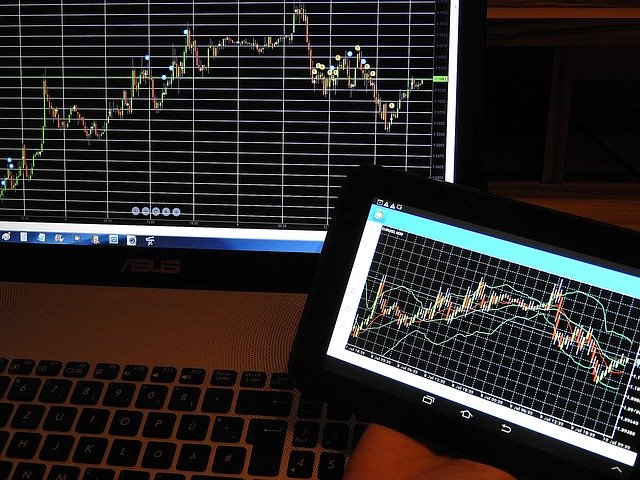
How to Use Forex Robots Successfully
If you have decided to use a forex robot, here are a few ideas on how you can maximise your chances of using a robot successfully:
Step 1. Don’t Expect Too Much
It might sound obvious, but it’s important to remember that robots are just that – robots. That means they can only perform the functions they were originally created to carry out.
They are unable to use any elements of creative thinking to envisage what might happen in the future. They can only use their programming and the data they gather relating to past performance to make predictions.
If you choose to use a forex robot, try not to rely on it completely when it comes to carrying out your trading activities.
To reap the rewards of trading, you will also need to apply your own observations and research – for example, it is sensible to keep on top of economic changes and the international financial climate.
Step 2. Do Your Research
Unfortunately, many robots are hindered by viruses and hackers so it’s important to ensure you find a reputable option. To avoid scams, choose a robot which has been on the market for some time, making sure that there are plenty of positive reviews and online testimonials.
Always be mindful that some reviews may not be genuine and be very wary of new forex robots that pop up overnight with hundreds of glowing reviews, even if the creator claims to be offering incentives such as a money-back guarantee.
Don’t rely on the fact that a robot has been backtested – many programmers ‘cherry-pick’ the backtest with the best results to use within the marketing of their robot, even if they carried out hundreds of other backtests which did not demonstrate accurate predictions.
Step 3. Use the Trial Software First
Many forex robot programmers offer a free trial of the software before expecting you to make a financial commitment.
Always take advantage of this and consider trying out more than one software option to see which suits your personal trading style and profit expectations the best.
Step 4. Set up Trading Parameters
Before you begin trading forex, set aside some time to create a trading plan – and make sure that you stick to it.
Your plan will need to include information such as your risk tolerance levels and profit goals. Once you have decided on this information, ensure that you update the parameters of your forex robot to ensure that it performs in line with your personal preferences.
Step 5. Keep a Close Eye on Your Robot
As explained previously, a forex robot cannot consider external influences which have an impact on the ever-changing forex market conditions.
This means that you will need to regularly check in on the trading activities it is performing, stay updated on the financial climate and adjust your parameters accordingly.
Things to Consider When Trading With a Forex Robot
Trading with the best forex robot on the market is still precarious. The majority of robots only trade within a narrow range, making a set amount of pips (this stands for ‘percentage in point’ – the measure of change in a currency pair) inside that range. They will often make profits, but those profits can easily be wiped out if a breakout occurs.
If you are looking to purchase a forex robot, consider the following:
-
It is illegal to sell a robot that doesn’t work and it is illegal for a seller to exaggerate the profitability of the robot they are trying to sell. However, it is not illegal for you to use one of these illegitimate robots, and you have no comeback if you make a loss (the seller can’t be held responsible for your losses).
-
It is common for a broker to refuse a trader the right to use a robot, because of concerns it could ruin their account.
-
A forex robot can be programmed to trade 24 hours a day, and that means having access to your money 24 hours a day. You can’t be watching all the time, which means your robot can trade without you – risky if you happen to have purchased an illegitimate robot. It is easy to lose money.
-
It is possible to develop your own robot, which can be a safer alternative than placing your trust with a third party.
How to Pick a Legitimate Forex Robot Seller in 2025
If everything seems legitimate and you’re close to purchasing your forex robot, there are still some simple checks you can make to ensure the company is legitimate:
-
Contact a regulatory authority (Financial Conduct Authority if you’re UK-based) and see if they will provide you with a list of companies that are regulated (and details of any cases currently open against regulated companies).
-
UK-based traders can use the FCA’s Financial Services Register tool to search for a firm.
-
Visit whois.net to check whether or not the company’s domain is registered in the same name as the company, and when the domain was set up.
-
Google key terms like: ‘unregulated broker forex robot’ to get lists of companies that have been exposed for being illegitimate.
-
Forexfraud.com has a list of brokers to avoid – these aren’t robot specific, but could still flag a company you are considering buying from.
How to Design an Automated Trading Strategy
While some forex robots are customisable to a certain extent, traders may struggle to find a commercial system that exactly fits their own strategy and goals. And many robots fail to deliver the results they promise.
So, some traders choose to design their own automated trading system instead. This allows for a much greater degree of flexibility as your only limitations will be your own creativity and capabilities, and what it is possible to code. And, if you build a successful system, you may be able to sell it to other traders.
To design a system for yourself, you will need a thorough understanding of the forex market and technical analysis. If you are not able to code yourself, you will need to hire a developer to do it for you.
It generally takes about six months to design, build and test an automated trading system, so you should be prepared to put in the time and effort required.

If you decide that you are able to design an automated trading strategy yourself, there are several steps that you will need to take:
Decide on a Trading Plan
Before designing an automated system, you need to have a detailed plan for how you are going to trade.
Clearly defining your trading aims and how your automated system will help you achieve them is crucial for creating a robot that works. You will need to consider aspects such as when you want your automated system to trade and the risk/reward ratio.
The best way to come up with an effective plan is to trade manually on the live market over a number of months. Try to keep your plan as simple as possible or it will become very difficult to programme your forex robot.
Define Your Trading Rules
Trading rules will be at the core of your automated system, so you must make sure you have considered all those that may apply.
If you are using a developer to code your system you will also need to be able to explain these to them in detail. Rules to think about include:
- Lot size
- Trade entries
- Which indicators to use
- Indicators
- Trading hours
Choose Your Risk Settings
Again, you must be very specific about the risk management tools you will use. If you decide to sell your automated system, buyers will look at its risk settings before its profits.
Things to consider include:
- Stop losses
- Maximum leverage
- Maximum drawdown
Code Your System
Once you have worked out your system on paper, you will need to convert it into code.
Different platforms use different coding languages, so you will need to consider that when designing.
While it would be helpful to have some understanding of coding yourself, if you’re not an expert, you can hire someone to do it for you. In this case, you will need to be able to explain your strategy and design to them very clearly.
Backtest Your System
Once your automated trading system is complete, you should backtest it using historical data. This should give you a good idea of how well your system will perform and allow you to make any refinements.
Free backtesting software can be found online.
Forward Test Your System
While backtesting is very useful, it does not take into account all the variables of a live trading situation. So, once you are happy with your backtesting, you should try your automated strategy out on the live market.
You could do this on a demo account, or a real account using small amounts of money.
Monitor and Analyse
When you have tested your system thoroughly, you are ready to put your automated trading strategy into action.
However, even now you cannot simply sit back and let it do all the work for you. You will need to stay on top of any unforeseen problems or changing market conditions and keep tweaking your system accordingly.
Frequently Asked Questions
Forex bots can be a very useful tool if you are unable to continually monitor your trading. They can offer the opportunity to carry out transactions automatically, meaning that you can follow your trading strategy even if you aren’t available at the time. This doesn’t mean that they are without risks, however, and you should be aware of both the risks and benefits before making a decision.
There are many reasons why people find using robots beneficial. Primarily, people like the fact that robots allow them to trade 25/7. This allows them the opportunity to trade on different markets in different time zones when ordinarily that would mean being awake in the middle of the night. Trades are also not affected by emotions or worries and transactions can occur much more quickly than when performed manually.
If you would like to trade Forex, but don�’t have time to perform each transaction yourself, then a bot can be very useful. They offer you the opportunity to trade and build your portfolio without needing to spend all of your time on the trading platform.
Forex bots are primarily used by beginner traders and those who don’t have the time to continually monitor their trades. The level of use is variable within these groups, with some people basing their entire strategy on the bots, and others mixing manual trading with the robots.
There are several different options to choose from and the right one for you will depend largely on your needs. Because of this, there isn’t really a ‘best’ option. The best choice for you will be the one which has the features that you need.
No. As with all things, there is always the potential for bots that don’t do what they say they will.
You should always check whether a robot is legitimate by considering the following:
- If it is very cheap or free this should ring alarm bells
- If the seller claims that it will make you rich very quickly then this is potentially a scam
- If your virus checking software alerts you then it’s likely there is a problem
- If the company selling the robot can’t prove its legitimacy or appears to be suspicious
Even though there are obvious benefits, it is important to be aware of the potential negatives associated with using Forex bots.
Some of these include:
- They don’t work well without a strong internet connection
- They aren’t always able to predict the fast-paced changes of Forex
- They aren’t always able to interpret data properly
- There is the potential for the bot to be a scam
There are several things to think about before you decide to purchase and use a Forex robot.
Some of the important things to think about include:
- Your robot will be able to trade 24/7. This means that it will have access to your funds even when you aren’t there to monitor it. There is always the potential for the robot to make trades you would have preferred to avoid.
- If you purchase a scam bot and use it, it can be very hard and even impossible to get your money back.
- If you're not sure about using a robot designed by someone else, you may be able to create and program one of your own.
- Forex robots are generally legal, but their use is sometimes frowned upon and some countries don’t support the use of bots.
VPS is a Virtual Private Server that allows users to be connected to the markets 24/7. This enables you to make trades at all times of day or night and protects against the issues which can come from lost connections.
There are two types of bot to consider: semi-automated and fully-automated. As the names suggest, these Forex robots are designed to provide different levels of service depending on your needs.
There is nothing that can guarantee a long-term profit when it comes to trading. The markets are variable and can be temperamental. Having said this, bots are a good way of making consistent trades and can be used to help guide trading decisions in the long term.
Although trading bots have grown in popularity and use over recent years, they are unlikely to ever completely replace manual trading. Even if traders choose to use robots for the majority of their trades, they will still need people to trade the bots and teach them how to work.
The GPS Robot3 is considered to be the next generation in Forex trading bots.
It is claimed to be 98% accurate in the trades that it performs, offering a potentially much higher rate of reliability than its competitors.
Final Thoughts
Since the forex market conditions are constantly evolving, only the most experienced forex traders can recognise the best and worst times to enter the market. There are a whole host of forex robots available – some are free, while others can cost thousands of pounds.
The golden rule is that if something seems too good to be true, it probably is. Even if a forex robot has been marketed well and looks as though it will be highly profitable, you should always proceed with caution before spending any money.
It is tempting to believe that you can simply sit back while an automated system does all the work for you. However, if this was the case forex robot developers would be getting rich by using them themselves, rather than selling them.
Sometimes, forex robot software will react to false price spikes or incorrect data that a human trader would be able to disregard as an anomaly. There are so many different variables to take into account that nobody (not even a robot) should solely rely on historical data to accurately predict what might happen in the future forex market.
A well-chosen forex robot may have a place as part of your trading strategy but you should not depend on it entirely. Successful trading requires human skill and effort that no robot can replace.
Many experienced traders suggest robots should not be used until a trader is proficient at manual trading, so that they are knowledgeable enough to distinguish between a well-built robot and a scam.
Instead of spending money on a forex robot, new traders will usually reap better rewards by opening a demo trading account. This can be used to improve their overall knowledge, practice trading and find a profitable strategy to be used later in real-life forex markets.
